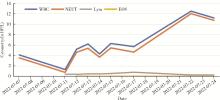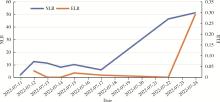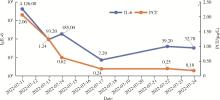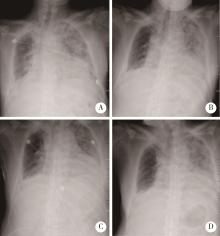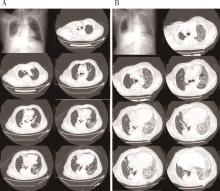Journal of Peking University (Health Sciences) ›› 2024, Vol. 56 ›› Issue (5): 932-937. doi: 10.19723/j.issn.1671-167X.2024.05.029
Previous Articles Next Articles
Immune-related severe pneumonia: A case report
Jiajun LIU1, Guokang LIU2, Yuhu ZHU2,*( )
)
- 1. Shihezi University School of Medicine, Shihezi 832000, Xinjiang Vygur Autonomous Region, China
2. Department of Hematology, Oncology and Rheumatology, Dushanzi People's Hospital, Karamay 833699, Xinjiang Vygur Autonomous Region, China
CLC Number:
- R563.1
| 1 | 周巧, 余荷, 梁宗安. 免疫检查点抑制剂导致免疫相关性肺炎[J]. 中国呼吸与危重监护杂志, 2021, 20 (10): 753- 756. |
| 2 |
Yin JQ , Wu YJ , Yang X , et al. Checkpoint inhibitor pneumonitis induced by anti-PD-1/PD-L1 therapy in non-small-cell lung cancer: Occurrence and mechanism[J]. Front Immunol, 2022, 13, 830631.
doi: 10.3389/fimmu.2022.830631 |
| 3 |
宋博, 邬明歆, 贾英杰, 等. PD-1/PD-L1抑制剂引起免疫相关性肺炎的研究进展[J]. 国际肿瘤学杂志, 2020, 47 (10): 627- 629.
doi: 10.3760/cma.j.cn371439-20200609-00091 |
| 4 |
Fujiwara Y , Horita N , Namkoong H , et al. The effect of adding immune checkpoint inhibitors on the risk of pneumonitis for solid tumours: A meta-analysis of phase Ⅲ randomised controlled trials[J]. Eur J Cancer, 2021, 150, 168- 178.
doi: 10.1016/j.ejca.2021.03.012 |
| 5 | 韩利会, 田辉, 杨秋安. 中性粒细胞/淋巴细胞比值对晚期肺癌免疫检查点抑制剂相关性肺炎的预测价值[J]. 中国当代医药, 2022, 29 (20): 20- 25. |
| 6 | Banavasi H , Kim S , Alkassis S , et al. Immune checkpoint inhibitor-induced pneumonitis: Incidence, clinical characteristics, and outcomes[J]. Hematol Oncol Stem Cell Ther, 2023, 16 (2): 144- 150. |
| 7 | 周潇翔. 抗PD-1/PD-L1免疫治疗的不良反应谱及其预测标志物探究[D]. 北京: 北京协和医学院, 2021. |
| 8 | 免疫检查点抑制剂相关肺炎诊治专家共识[J]. 中华结核和呼吸杂志, 2019, 42(11): 820-825. |
| 9 | 王杰, 蒋士卿, 王涛. 免疫检查点抑制剂相关性肺炎的研究进展[J]. 实用临床医药杂志, 2022, 26 (10): 135-138, 143. |
| 10 | 代丽源, 石远凯, 韩晓红. 免疫检查点抑制剂治疗晚期非小细胞肺癌的预后标志物动态监测研究进展[J]. 协和医学杂志, 2022, 13 (2): 287- 295. |
| 11 |
赵喆, 唐彦, 朱惠娟, 等. 免疫检查点抑制剂引发的免疫相关不良反应研究进展[J]. 临床药物治疗杂志, 2022, 20 (6): 1- 6.
doi: 10.3969/j.issn.1672-3384.2022.06.001 |
| 12 |
Thomas R , Sebastian B , George T , et al. A review of the imaging manifestations of immune check point inhibitor toxicities[J]. Clin Imaging, 2020, 64, 70- 79.
doi: 10.1016/j.clinimag.2020.04.007 |
| 13 | 李彩丽, 翟沙, 张静, 等. 感染性休克外周血单核细胞TLR4/MyD88/NF-κB p65信号通路表达[J]. 中华医院感染学杂志, 2022, 32 (13): 1931- 1935. |
| 14 | 曹蒙, 王涛. 凝血功能、炎性因子和细胞免疫功能在感染性休克患者中的检测意义[J]. 血栓与止血学, 2022, 28 (2): 260- 261. |
| 15 | 王威, 张迎庆. 去甲肾上腺素急救治疗脓毒症休克的临床效果及其对炎性因子的影响研究[J]. 北方药学, 2021, 18 (10): 38- 39. |
| 16 | 马丽云, 闫春良, 赵秋红, 等. 免疫检查点抑制剂治疗非小细胞肺癌引起相关肺炎的临床分析[J]. 癌症进展, 2021, 19 (8): 810- 813. |
| 17 | Wang HP , Guo XX , Zhou JX , et al. Clinical diagnosis and treatment of immune checkpoint inhibitor-associated pneumonitis[J]. Thorac Cancer, 2020, 11 (1): 191- 197. |
| 18 | 中国临床肿瘤学会指南工作委员会作. 中国临床肿瘤学会(CSCO)免疫检查点抑制剂相关的毒性管理指南2021[M]. 北京: 人民卫生出版社, 2021: 4. |
| 19 | Henderson Berg MH , Del Rincón SV , Miller WH . Potential therapies for immune-related adverse events associated with immune checkpoint inhibition: From monoclonal antibodies to kinase inhibition[J]. J Immunother Cancer, 2022, 10 (1): e003551. |
| [1] | YANG Duo,ZHOU Xin-na,WANG Shuo,WANG Xiao-li,YUAN Yan-hua,YANG Hua-bin,GENG Hui-zhen,PENG Bing,LI Zi-bo,LI Bin,REN Jun. Assessment of lymphocytic function in vitro stimulated by specific tumor polypeptide combined with dendritic cells [J]. Journal of Peking University (Health Sciences), 2021, 53(6): 1094-1098. |
| [2] | Jia-xing LIU,Gui-ping HU,Lin ZHAO,Yong-ming ZHANG,Li WANG,Guang JIA,Rui-xiang LIU,Hui-min FENG,Hua-dong XU. Early effects of low-level long-term occupational chromate exposure on workers’ health [J]. Journal of Peking University(Health Sciences), 2019, 51(2): 307-314. |
| [3] | DOU Jing-li,BAI Li,PANG Chun-yan,ZHANG Wen-lan,ZHANG Wei,WANG Yong-fu. Therapeutic effect of adipose tissue-derived stem cells on bleomycin-induced mice of scleroderma [J]. Journal of Peking University(Health Sciences), 2016, 48(6): 970-976. |
| [4] | AN Le-mei, LI Juan, JI Lan-lan, LI Guang-tao, ZHANG Zhuo-li. Detection of peripheral follicular helper T cells in rheumatoid arthritis [J]. Journal of Peking University(Health Sciences), 2016, 48(6): 951-957. |
| [5] | WANG Zhi-hua, ZHANG Wei, ZHANG Yan-qing, PANG Chun-yan,WANG Yong-fu. Effect of CD40 siRNA on inflammatory response of MRL/Lpr mice [J]. Journal of Peking University(Health Sciences), 2016, 48(5): 771-776. |
| [6] | LI Hao, ZHANG You-Yi. Roles of proinflammatory cytokines in cardiac remodeling induced by sympathetic nervous system /catecholamine [J]. Journal of Peking University(Health Sciences), 2014, 46(6): 1001-1004. |
|
||
